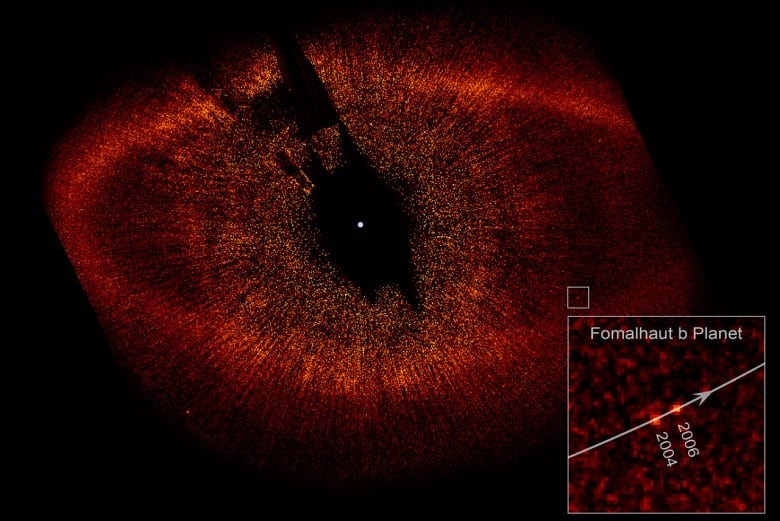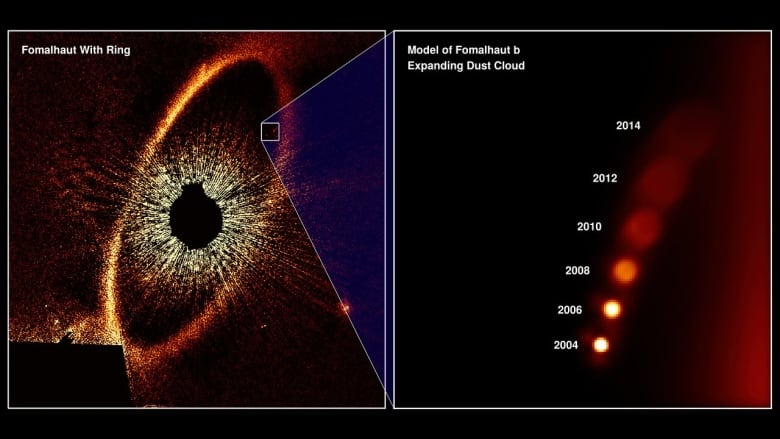Science
Exoplanet orbiting nearby star 'disappears' – CBC.ca

In 2008, NASA announced that a new exoplanet was found orbiting a star 25 light-years away. But now it seems to have vanished.
It turns out that it likely wasn’t a planet at all.
The initial observation of the potential exoplanet, named Fomalhaut b, was made in 2004 using the Hubble Space Telescope, with follow-up observations in 2006.
The host star, Fomalhaut, has long fascinated astronomers. The star is found in the southern constellation Piscis Austrinus and is surrounded by a cloud of dust. Images reveal it to look like the fictional Eye of Sauron in the movie The Lord of the Rings.
While most exoplanets are discovered through the transit method — when a star’s light dips ever so slightly as the planet crosses in front of it — this was directly observed by Hubble. And the dot appeared to be moving, thus supporting evidence of an exoplanet.
But additional observations by Hubble in 2014 revealed … nothing.
This exoplanet wasn’t making any sense at all.
“Fomalhaut b has always been a mystery,” Andras Gaspar, an astronomer at the University of Arizona and corresponding author of the new paper published in the journal Proceedings of the National Academy of Sciences, said in an email. “For starters, its colours were a bit off from what one would expect from a massive exoplanet.”
But stranger still, in Hubble’s initial images, the “planet” was bright in visible light but produced no heat signature in infrared light, as an object like this should. Some of the hypotheses for this was that there could be a ring of dust around Fomalhaut, or the planet was similar to Saturn and itself sported a massive ring.
Then Gaspar and corresponding author George Rieke looked through data and realized that Fomalhaut b wasn’t where it was supposed to be, which further piqued their curiosity.
What Hubble actually witnessed
Their paper concludes that instead of an exoplanet, what Hubble witnessed was a rare collision between two large, icy asteroids that produced fine dust particles.
Following recommendations from one of the reviewers of their paper, they went back and analyzed the object and noticed that it was expanding, further strengthening their case of an expanding cloud of dust.
Capturing something like this is rare. It just happened to be a case of Hubble looking in the right place at the right time. But it’s not without precedent, Gaspar said.
“Sometimes we do get lucky and see an unlikely event,” he said. “Humans have observed and noted quite a few supernovae going off over the last millenia; we have seen the Shoemaker-Levy 9 comet impact Jupiter; the massive Tunguska impact [in Siberia] in 1908 went undiscovered for years.”


Catching something of this magnitude is important for understanding how planets and star systems form.
“The Fomalhaut system is the ultimate test lab for all of our ideas about how exoplanets and star systems evolve,” Rieke, also from the University of Arizona, said in a statement. “We do have evidence of such collisions in other systems, but none of this magnitude has ever been observed. This is a blueprint for how planets destroy each other.”
Rieke and Gaspar have booked time for follow-up observations on the upcoming James Webb Space Telescope, set to launch in 2021.
“Witnessing such an event, as rare it is, is fascinating. The Earth-moon system formed in a massive collision (much more massive than this),” Gaspar said. “Collisions produce the asteroid fragments that impact Earth to this day and provide us with shooting stars to see at night, and large asteroids that movies have taught us to fear and that we are actively searching for.”
Science
Giant prehistoric salmon had tusk-like teeth for defence, building nests


|
|
The artwork and publicity materials showcasing a giant salmon that lived five million years ago were ready to go to promote a new exhibit, when the discovery of two fossilized skulls immediately changed what researchers knew about the fish.
Initial fossil discoveries of the 2.7-metre-long salmon in Oregon in the 1970s were incomplete and had led researchers to mistakenly suggest the fish had fang-like teeth.
It was dubbed the “sabre-toothed salmon” and became a kind of mascot for the Museum of Natural and Cultural History at the University of Oregon, says researcher Edward Davis.
But then came discovery of two skulls in 2014.
Davis, a member of the team that found the skulls, says it wasn’t until they got back to the lab that he realized the significance of the discovery that has led to the renaming of the fish in a new, peer-reviewed study.
“There were these two skulls staring at me with sideways teeth,” says Davis, an associate professor in the department of earth sciences at the university.
In that position, the tusk-like teeth could not have been used for biting, he says.
“That was definitely a surprising moment,” says Davis, who serves as director of the Condon Fossil Collection at the university’s Museum of Natural and Cultural History.
“I realized that all of the artwork and all of the publicity materials and bumper stickers and buttons and T-shirts we had just made two months prior, for the new exhibit, were all out of date,” he says with a laugh.
Davis is co-author of the new study in the journal PLOS One, which renames the giant fish the “spike-toothed salmon.”
It says the salmon used the tusk-like spikes for building nests to spawn, and as defence mechanisms against predators and other salmon.
The salmon lived about five million years ago at a time when Earth was transitioning from warmer to relatively cooler conditions, Davis says.
It’s hard to know exactly why the relatives of today’s sockeye went extinct, but Davis says the cooler conditions would have affected the productivity of the Pacific Ocean and the amount of rain feeding rivers that served as their spawning areas.
Another co-author, Brian Sidlauskas, says a fish the size of the spike-toothed salmon must have been targeted by predators such as killer whales or sharks.
“I like to think … it’s almost like a sledgehammer, these salmon swinging their head back and forth in order to fend off things that might want to feast on them,” he says.
Sidlauskas says analysis by the lead author of the paper, Kerin Claeson, found both male and female salmon had the “multi-functional” spike-tooth feature.
“That’s part of our reason for hypothesizing that this tooth is multi-functional … It could easily be for digging out nests,” he says.
“Think about how big the (nest) would have to be for an animal of this size, and then carving it out in what’s probably pretty shallow water; and so having an extra digging tool attached to your head could be really useful.”
Sidlauskas says the giant salmon help researchers understand the boundaries of what’s possible with the evolution of salmon, but they also capture the human imagination and a sense of wonder about what’s possible on Earth.
“I think it helps us value a little more what we do still have, or I hope that it does. That animal is no longer with us, but it is a product of the same biosphere that sustains us.”
This report by The Canadian Press was first published April 24, 2024.
Brenna Owen, The Canadian Press





Science
Giant prehistoric salmon had tusk-like spikes used for defence, building nests: study


|
|
A new paper says a giant salmon that lived five million years ago in the coastal waters of the Pacific Northwest used tusk-like spikes as defense mechanisms and for building nests to spawn.
The initial fossil discoveries of the 2.7-metre-long salmon in Oregon in the 1970s were incomplete and led researchers to suggest the fish had fang-like teeth.
The now-extinct fish was dubbed the “saber-tooth salmon,” but the study published in the peer-reviewed journal PLOS One today renames it the “spike-toothed salmon” and says both males and females possessed the “multifunctional” feature.
Study co-author Edward Davis says the revelation about the tusk-like teeth came after the discovery of fossilized skulls at a site in Oregon in 2014.
Davis, an associate professor in the department of earth sciences at the University of Oregon, says he was surprised to see the skulls had “sideways teeth.”
Contrary to the belief since the 1970s, he says the teeth couldn’t have been used for any kind of biting.
“That was definitely a surprising moment,” Davis says of the fossil discovery in 2014. “I realized that all of the artwork and all of the publicity materials … we had just made two months prior, for the new exhibit, were all out of date.”





Science
SpaceX sends 23 Starlink satellites into low-Earth orbit


|
|
April 23 (UPI) — SpaceX launched 23 Starlink satellites into low-Earth orbit Tuesday evening from Space Launch Complex 40 at Cape Canaveral Space Force Station in Florida.
Liftoff occurred at 6:17 EDT with a SpaceX Falcon 9 rocket sending the payload of 23 Starlink satellites into orbit.
The Falcon 9 rocket’s first-stage booster landed on an autonomous drone ship in the Atlantic Ocean after separating from the rocket’s second stage and its payload.
The entire mission was scheduled to take about an hour and 5 minutes to complete from launch to satellite deployment.
The mission was the ninth flight for the first-stage booster that previously completed five Starlink satellite-deployment missions and three other missions.





-



 Health23 hours ago
Health23 hours agoRemnants of bird flu virus found in pasteurized milk, FDA says
-
News19 hours ago
Amid concerns over ‘collateral damage’ Trudeau, Freeland defend capital gains tax change
-
Art23 hours ago
Random: We’re In Awe of Metaphor: ReFantazio’s Box Art
-
Art17 hours ago
The unmissable events taking place during London’s Digital Art Week
-
Tech24 hours ago
Surprise Apple Event Hints at First New iPads in Years
-



 Politics21 hours ago
Politics21 hours agoHow Michael Cohen and Trump went from friends to foes
-
Science22 hours ago
NASA hears from Voyager 1, the most distant spacecraft from Earth, after months of quiet
-
Media22 hours ago
Vaughn Palmer: B.C. premier gives social media giants another chance





